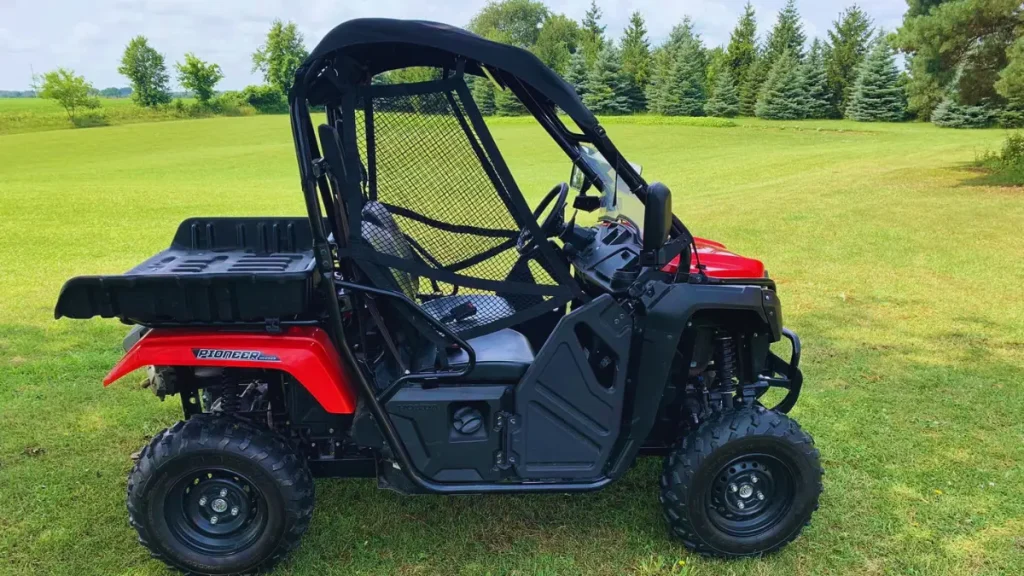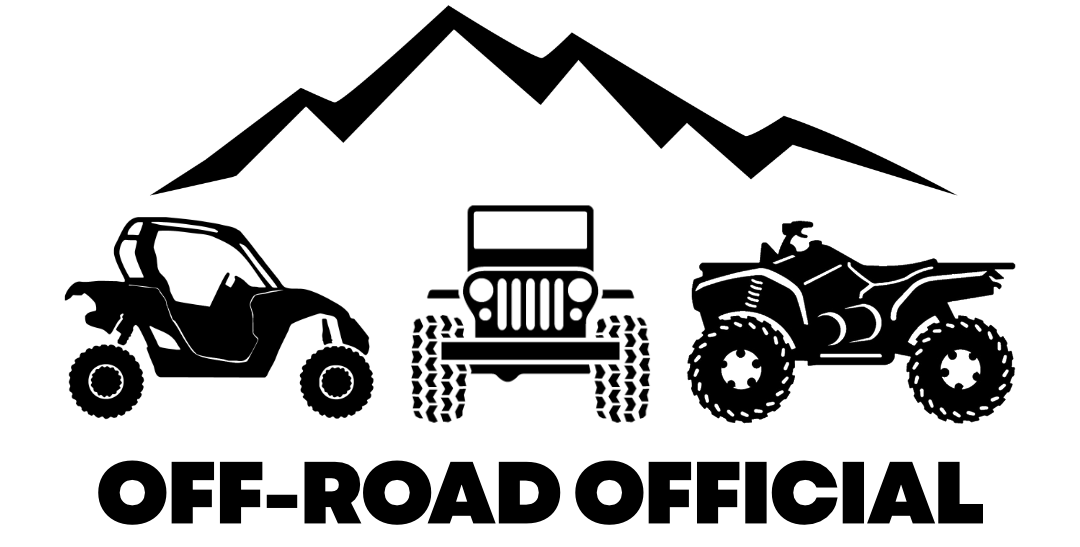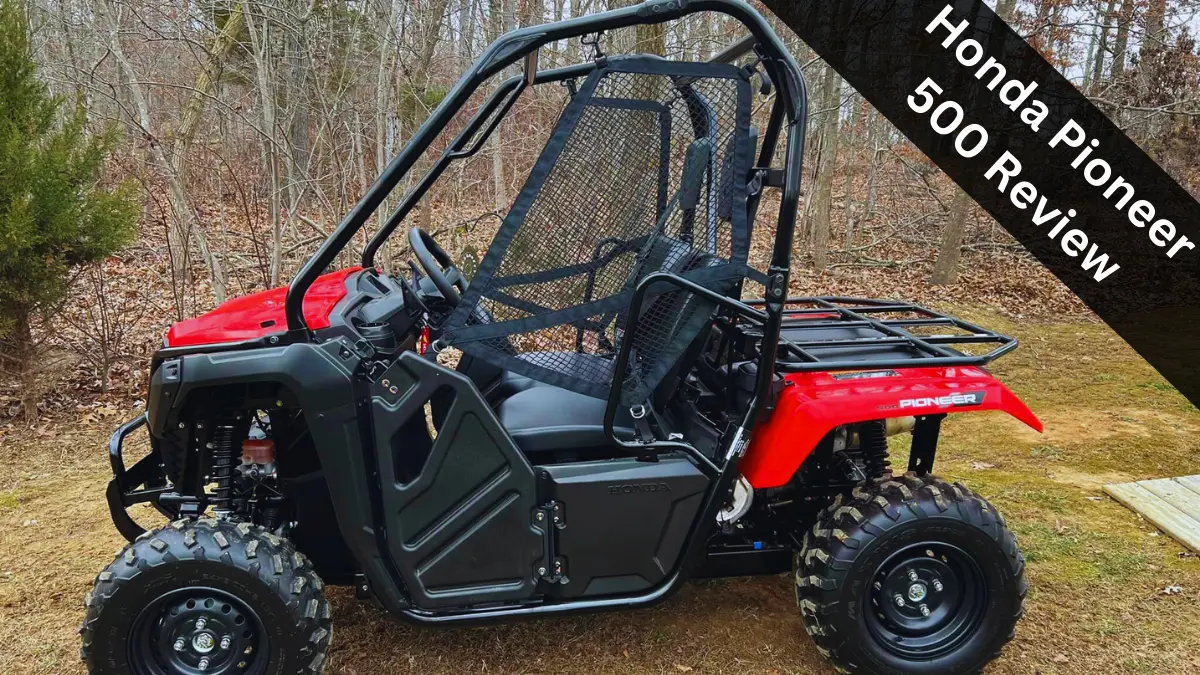If you’re looking for a solid but simple side-by-side for a reasonable price, Honda’s line of Pioneer models should be right up your alley.
There are the Pioneer 1000 models, which are the fastest and most powerful in Honda’s line of utility-focused side-by-sides.
A step below that are the Pioneer 700 models.
Next is the Honda Pioneer 520, which debuted just a few years ago.
And then there’s the Pioneer 500, Honda’s entry level side-by-side and one its best sellers.
While the Pioneer 500 is about as basic as it gets, you can be pretty darn sure that it’ll rarely need a visit to the shop aside from standard maintenance.
But though the Pioneer 500 has plenty of strengths, you can’t overlook that it has some weaknesses as well – which are very similar to the drawbacks found with the Pioneer 520.
This guide will offer a detailed Honda Pioneer 500 review, shining a light on all of the good and bad with this model including:
- Key differences from the Pioneer 520
- Specifications
- Features
- Performance
- Top speed
- What owners like
- What owners dislike
Honda Pioneer 500 & 520
Both the Pioneer 500 and 520 are Honda’s small, simple side-by-side options and are only offered in one trim for 2023 and 2024.
The Pioneer 500 will set you back $8,999 for 2023, with the Pioneer 520 costing a grand more at $9,999.
Used Pioneer 500’s make for some of the best used side-by-sides money can buy for under $5,000 these days.
While these models are very similar, there are also some distinct differences between the two that account for the difference in cost.
No Cargo Bed – The most glaring difference is that the Honda Pioneer 500 does not feature a rear cargo bed, while the Pioneer 520 offers one that dumps.
The 500 model only offers a rear storage space with a utility rack, similar to what you’d find on Honda’s most popular ATV model.
Many owners will fashion their own small bed or purchase one to fit in this area.
The Pioneer 520 was actually rolled out as a response to years of owner complaints about the lack of a rear cargo bed in the 500 model.

Engine Power – The Pioneer 500 is also slightly less powerful than its big brother, with 43cc less of cylinder displacement in its engine.
That may not seem like much, but you can tell a slight difference in the low-end power each model provides when riding them.
Honda Pioneer 500 Review – Key Features, Specs & Performance
Engine
The Pioneer 500 is brought to life by a 475cc single-cylinder engine with liquid cooling.
True to the reputation they’ve built through the years, Honda engines including this one are as durable and dependable as you’ll find.
This engine will start right up and run in tip top shape day after day as long as you service it regularly.
As the smallest Honda side-by-side and built for work and more casual driving, the engine puts an emphasis on low-end torque which you can feel upon initial acceleration.
This impressive low-end power makes the Pioneer 500 capable of tackling sand, mud, shallow water, and hills with no issue.
But you’ll find that its power drops off in the upper RPM ranges, making it one of the slower models in its class and giving it limited recreational appeal.
The engine is quiet and smooth, so you’ll never have to worry about not being able to talk to your passenger while riding.
| Engine Type | Four-Stroke, OHV |
| Cylinder Arrangement | Single Cylinder |
| Displacement | 475 cc |
| Bore x Stroke Ratio | 92 x 71.5 mm |
| Compression Ratio | 9.5:1 |
| Fuel System | PGM-FI fuel injection |
| Engine Cooling | Liquid Cooling |
| Fuel Capacity | 4.1 Gallons |
Drivetrain
Like the rest of the Pioneer line, the 500 is unique from most other models in that its transmission is more like something you’d find in an automobile than other side-by-sides.
The tranny is a 5 speed automatic with an automatic clutch, and doesn’t use a drive belt.
While it has its advantages over your traditional CVT style transmission, you’ll find that gear shifts tend to be longer and are more noticeable when taking place, so it’s not quite as smooth as that of a CVT.
You can choose from either an Automatic or Manual mode with the transmission, with paddles providing the ability to shift when in Manual.
The Pioneer 500 offers both 2WD and 4WD, but there’s no locking differential.
Either way, when in 4WD, these models have been nicknamed the “billy goat” because they’ll climb and crawl pretty much any terrain at a slower pace.
| Drive System | 2WD/4WD, Driveshafts |
| Transmission Type | 5-Speed w/ Automatic/Manual Modes & Reverse |
| Gearshift | R-N-D |
Suspension
Many owners highlight the suspension system as one of the weak spots of this mostly solid side-by-side.
It is equipped with independent double wishbone suspension in the front and rear, but the stock shocks are not the best.
These lower quality shocks, combined with the minimal amount of travel and the small wheelbase, make for a rather bumpy ride.
Trails and off-road terrain will be rather jolting, but even on hard-packed dirt roads the ride is stiff and you’ll really feel any bumps or potholes.
The ground clearance is minimal as well, and you’ll find that you bottom this model out a good bit when riding uneven terrain.
| Turning Radius | 12.8 feet |
| Wheelbase | 73 inches |
| Max Ground Clearance | 8.5 in |
| Front Suspension | Independent Double Wishbone |
| Rear Suspension | Independent Double Wishbone |
| Front Travel | 5.8 in |
| Rear Travel | 5.9 in |
Tires & Brakes
The Pioneer 500 is equipped with 24-inch diameter tires in the front and rear.
These stock tires are fine when it comes to traction, but they’re some of the smaller tires you’ll find on a side-by-side in this class.
Not only does this affect the ground clearance of these models, but it also gives them the look of a glorified golf cart rather than a utility side-by-side.
The good news is that you can throw on some bigger tires, up to 27 inches in size, without needing to lift the Pioneer or worry about them rubbing.
If you add bigger tires and some aftermarket shocks to the Pioneer 500, these models will take you pretty much anywhere you want to go and make for great trail riding options.
The hydraulic disc brakes on this machine are excellent and will stop you on a dime at pretty much any speed.
| Front Tires | 24 x 8-12 |
| Rear Tires | 24 x 10-12 |
| Wheels | Stamped Steel (12-inch) |
| Front Brake Type | Hydraulic Disc (210 mm) |
| Rear Brake Type | Hydraulic Disc (170 mm) |
Dimensions
The Pioneer 500 benefits from being one of the smallest models in its class in a couple different ways.
It’ll fit into the bed of a full-sized pickup, though you’ll likely need to leave the tailgate down and strap it in.
There aren’t many trails or tight wooded areas these models can’t snake through with their 50-inch widths.
And at only 1,027 lbs, this machine is generally pretty easy to control and handle, even in 4WD.
As you’d expect, this compact size does cause some issues for taller riders as the cab space and legroom can feel a bit cramped.
If you’re a bigger fella riding with another bigger fella next to you, you’ll likely be shoulder to shoulder.
For a smaller machine, the excellent low-end torque means the Pioneer 500 can still tow an impressive 1,000 lbs.
And you can still load around 450 lbs onto the rear storage rack area and easily haul it where you need to go.
| Length | 102.6 in |
| Width | 50 in |
| Height | 71.2 in |
| Curb Weight | 1,027 lbs |
| Towing Capacity | 1,000 lbs |
| Rear Storage Capacity | 450 lbs |
Honda Pioneer 500 Top Speed
Though the Pioneer 500 has the low-end power and torque needed to tackle just about any trail, it’s not meant to be a recreational vehicle at all.
The engines are as good as you’ll find, but they’re not built for top-end speed and thus are installed with a rev limiter.
The Honda Pioneer 500 top speed is between 37-40 mph, with the rev limiter kicking in in that range and preventing it from going any faster.
What Owners Like
- Very well-made side-by-sides – you’ll rarely need to make repairs to any components.
- Engine is about as bulletproof as they come.
- Plenty of low-end power to perform most working tasks and take on most terrains with no issue.
- These models are nicknamed the ‘billy goat” for their ability to crawl up essentially any terrain.
- Small enough to fit in the bed of a full-size pickup truck so you won’t need a trailer.
- Drive belt-less transmission helps avoid any of the usual drive belt related maintenance.
- Some of the more reasonably priced “big-name” side-by-side models.
What Owners Dislike
- Some of the slowest models in their class, offering limited recreational ability.
- No storage space in the cab area.
- Lack of power steering can make it harder on smaller riders’ arms when in 4WD.
- Stock suspension makes for a stiff and bumpy ride, even on dirt roads.
- Ground clearance is minimal, leading to some scraping and bottoming out in tougher terrains.
- The stock tires are small for the class and can have you confusing the Pioneer 500 for a golf cart.
- No rear dumping cargo bed.
- The transmission in new units can be harsh when shifting for the first hundred miles or so until broken in
Find out more on some of the drawbacks with these models in this guide to the Honda Pioneer 500’s most common problems.
Final Word
The Honda Pioneer 500 won’t impress you with its appearance or recreational ability, but it’s as dependable as they come and will start right up and run year after year.
If you’re looking for a basic side-by-side to carry you around your property and help with working tasks, these models are worth a look.
There are some similar models you may want to consider, so check out the following before you go:


